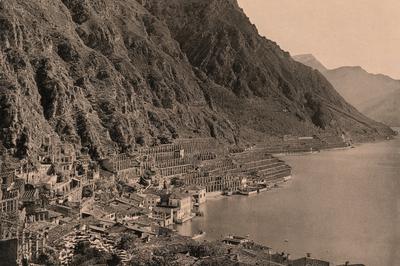Saturday 18th March | 6 pm

Altitudes of vision. The softening of the landscape from the Alps to Garda describes through pictures the descent from the highest peaks of the Alps and the Dolomites to Lake Garda, via a selection of photographs from the years between 1880 and 1930 preserved in the archives of the MAG and including a 1912 film by Pietro Marelli, Bellezze Italiche. Trento e dintorni (Italian beauty spots. Trento and surroundings), restored by the Fondazione Cineteca Italiana.
The Altitudes of vision. The softening of the landscape from the Alps to Garda exhibition is divided into four sections, arranged in part on light-screens and in part on displays, corresponding to four stages in the change of landscape from the peaks to the lake.
A silent conversation with the sun
The first section of the exhibition documents the glaciers and peaks between approximately 3900 and 1500 metres above sea level. The images show how the high mountains appeared to travellers in the late nineteenth and early twentieth century. In addition to the Biella-born Vittorio Sella, other great landscape photographers who portrayed the majesty of the peaks included, among others, Alois Beer, who travelled here between 1900 and 1910, Friedrich Würthle, a painter and engraver who in the second half of the nineteenth century opened a photographic studio in Salzburg, the Merano-born Leo Bahrendt and Franz Gratl of Innsbruck. The images show impressive peaks, the snow of the glaciers in the Zillertal Alps and the Brenta and Belluno Dolomites, but also works such as the road over the Stelvio Pass, opened to the public in the autumn of 1925.
The first settlements
The heights located immediately below the peaks are where we find the alpine lakes, including those of Misurina and Dobbiaco, and the first settlements, which,to those who visited the region between 1880 and 1930, would have appeared merely as simple and modest villages. In the background can be seen the imposing Dolomites, forming a backdrop to what were then small hamlets, such as Cortina d’Ampezzo, Pinzolo and Brunico. In this section, visitors will see a selection of images from the photographic campaigns of Josef Gugler of Bolzano, of Bernard Johannes and the work of Giovanni Battista Unterveger, who created a sequence of views of the Trentino on commission to the SAT (Società degli alpinisti tridentini) between 1881 and 1882.
The valley floor
Dropping down from the heights, we come to the valley floor. Here, the region is characterised by very different landscapes, from the Valle di Cembra and its terraced slopes photographed by the Pedrotti brothers, to the Peio springs, the views of the lakes of Toblino, Levico and Caldaro, and the rocks that mark the Valle del Sarca. Here too, there are larger towns, such as Bolzano, Merano and Trento: indeed, the protagonists of this group of images are the towns and their visual relationship with the mountains that frame them, establishing a dialogue between the grandeur of the mountains, now in the background, and the softness of the valley floor. This section again includes images by G.B. Unterveger, Alois Beer and Friedrich Würthle.
A display of wealth and grace
The journey through pictures ends near Lake Garda, where the Alpine landscape meets and merges with the northernmost Mediterranean scrub in Italy today. The rocks change significantly here, and the vegetation also changes considerably with the morphology of the territory, as does the role of light in this context. This final stage is narrated by many images belonging to the holdings of Photoglob of Zurich present in the MAG: they are early twentieth-century photographs clearly intended to be recognisable, almost topographical. In this last section, we also find some panoramic shots by Alois Beer and the territory of Nago portrayed by Giorgio Sommer, with the Mori-Arco railway visible on the right.




